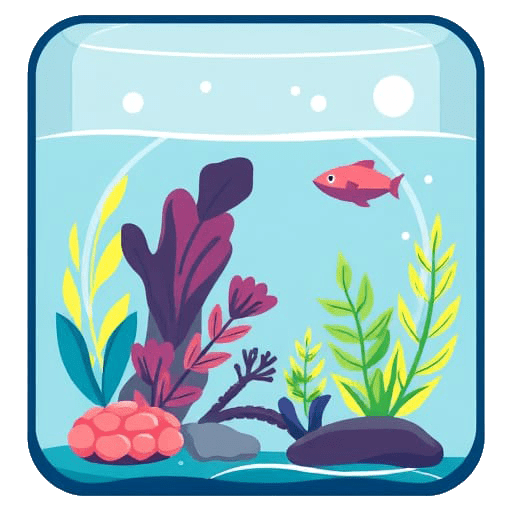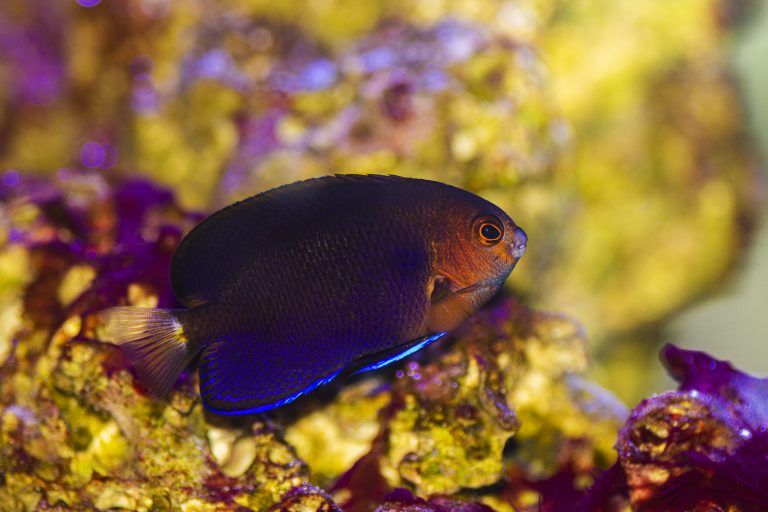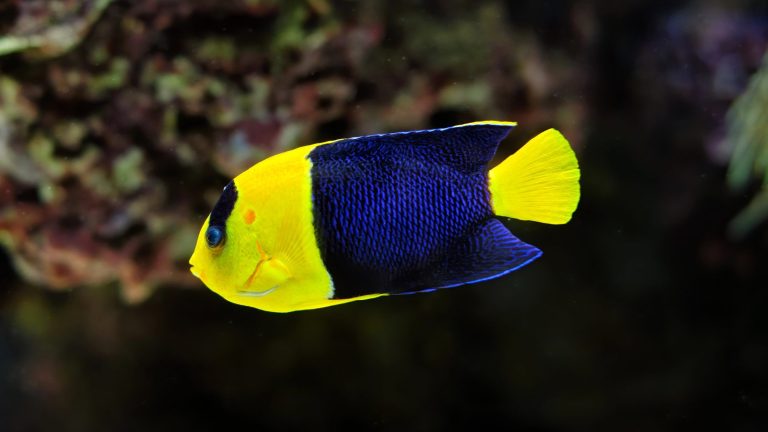Clarkii Clownfish (Amphiprion clarkii) are an easy-to-care-for species of Clownfish due to their incredible hardiness. They’re often overlooked compared to the more popular Ocellaris Clownfish, but they’re a very cool-looking fish with interesting personalities. If you look closely enough, you can see some similarities between Clarkii’s and Ocellaris Clowns, specifically the fins and vertical white stripes. Clarkii Clownfish have yellow, black, and white colors throughout, with a taller body compared to other Clownfish.
The Clarkii Clownfish can be semi-aggressive and may dart towards your hand to nibble you if you get too close to their territory. They also grow a bit bigger compared to most other species of Clownfish, maxing out at around 6 inches when they’re fully grown. A nibble from a 6-inch fish will definitely hurt, so use caution. This article will discuss Clarkii Clownfish aquarium requirements, dietary needs, tank mate compatibility, and more.
Aquarium Requirements
Due to their size when fully grown, Clarkii Clownfish should not be kept in anything smaller than 30 gallons. It never hurts to have a larger aquarium, if possible. Having some live rock is recommended for cover (and filtration), but Clownfish don’t necessarily use rockwork as intensively as Dottybacks, Blennies, and other saltwater fish. Clownfish aren’t commonly known as jumpers, but I would recommend providing a lid on the aquarium just in case. Although rare, I have experienced some jumping Clownfish.
Is the Clarkii Clownfish Reef Safe?
Clarkii Clownfish are generally reef safe. They should not eat coral or invertebrates in the aquarium. However, they may pester soft coral in an attempt to pair and be hosted by the coral, which can stress the coral out. These Clownfish are more likely to naturally seek to be hosted by an anemone or coral compared to other Clownfish. You’ll be able to host them with just about any anemone. The go-to anemone for Clownfish hosting is usually the Bubble-Tip Anemone, but Clarkii’s can be kept with Sebae, Carpet, and many other anemone species.
Water Parameters
Saltwater fish thrive in stable, well-maintained marine environments with specific water parameters that support their health and longevity. This is equally as true for the Clarkii Clownfish. Ideal conditions for many saltwater fish include a pH range of 8.1 to 8.4 and alkalinity (dKH) between 8 and 12. The salinity should be kept between 1.020 and 1.024 specific gravity to closely mimic natural seawater. Maintaining a consistent temperature between 72 and 78 degrees Fahrenheit (22 to 26°C) is crucial for reducing stress and promoting overall well-being. These parameters provide a stable environment in which Clarkii Clownfish can thrive and display their natural behaviors. If you’re looking for ways to test salinity levels in your aquarium, look no further than “Different Salinity Reading Tools for Saltwater Fish Tanks”.
Food & Diet
Just like other Clownfish species, Clarkii Clowns are omnivorous. They should readily accept pellet food, flake food, and protein-rich foods like Mysis Shrimp and Brine Shrimp. I don’t think I have ever seen a Clownfish be a picky eater, which adds to why they’re often excellent choices for newer saltwater fishkeepers. Clarkii Clownfish are incredibly hardy and should have no issue consuming the provided food after introduction into an aquarium.
Tank Mates
Clarkii Clownfish are compatible with many peaceful and semi-aggressive marine fish. I have seen them kept with Blennies, Dottybacks, Dwarf Angels, Gobies, Tangs, Wrasses, and many other fish that fall into the peaceful and semi-aggressive category. It’s important to provide a large enough aquarium with plenty of hiding spaces. Clarkii Clowns can get large and quite aggressive as they grow. They may go after other fish, tongs, your hands, and anything else that goes into the fish tank, so beware.
I would avoid keeping more than a pair of Clarkii Clownfish in an aquarium. You’ll likely see aggression between Clownfish if there are more than two present. I also recommend not mixing different Clownfish species unless your aquarium is incredibly large, and you have an understanding of different Clownfish temperaments. People have claimed to keep multiple species of Clownfish in an aquarium together, but I discourage it to avoid any unnecessary aggression between fish.
Breeding
It is very possible to breed Clarkii Clownfish in captivity. I personally have never done it, but if a pair is present in an aquarium, they will likely do it on their own if water parameters fit their needs. The eggs and fry will likely get eaten if you do not intervene and remove them from the display aquarium. Saltwater fishkeepers claim they are harder to breed compared to Ocellaris Clownfish, but are not exceptionally challenging to breed overall. Here is a fantastic thread on breeding Clarkii Clownfish from Marine Aquariums South Africa if you’re interested in learning more.
Final Notes
Caring for Clarkii Clownfish is relatively straightforward, making them a great choice for both beginner and experienced marine aquarists. Their hardy nature allows them to adapt to a range of conditions, though they thrive best in stable, well-maintained environments with proper water parameters and plenty of swimming space. Providing live rock for shelter, a balanced diet of high-quality marine flakes, pellets, and frozen foods, and ensuring good water quality will help maintain their vibrant coloration and robust health.
While Clarkii Clownfish can be more territorial than other clownfish species, especially as they mature or when hosting an anemone, their behavior can be managed with careful selection of tank mates and appropriate tank size. They are also known to form strong bonds with anemones and can display fascinating symbiotic behaviors in the home aquarium. With the right setup and attention to their needs, Clarkii Clownfish can be long-lived, engaging, and visually striking additions to any saltwater tank.
Thanks for clicking this tab, this is planned for a future feature of this website!
Convict Tang – Complete Care Guide
The Convict Tang, which likely gets its name from the black striping and white coloration…
Ocellaris Clownfish – Complete Care Guide
Geometric Pygmy Hawkfish – Complete Care Guide
The Geometric Pygmy Hawkfish is a unique-looking saltwater fish. It is bulky, has a long…







